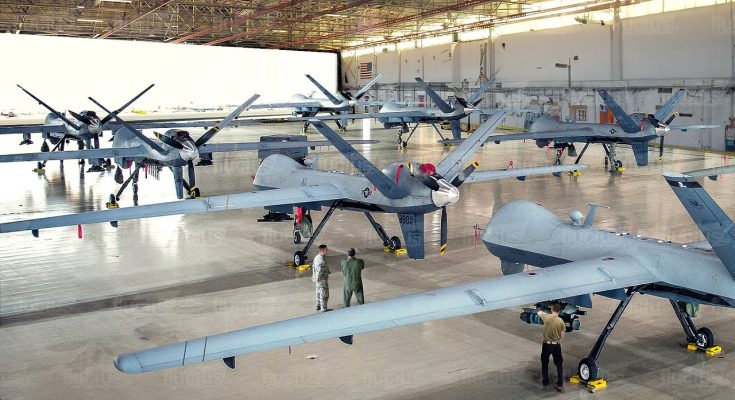The MQ-9 Reaper Drone is widely regarded as one of the most feared and capable drones ever made by the United States. Developed by General Atomics, the Reaper is a significant advancement over earlier unmanned aerial vehicles (UAVs) like the MQ-1 Predator. It has gained a reputation for its lethal precision, extended range, and its pivotal role in modern warfare, particularly in counterterrorism operations and surveillance. Its combination of endurance, firepower, and stealth has made it an indispensable tool for the U.S. military and a symbol of advanced warfare technology.
The MQ-9 Reaper’s Design and Capabilities
The MQ-9 Reaper is a medium-altitude, long-endurance (MALE) drone designed primarily for intelligence, surveillance, reconnaissance (ISR), and precision strike missions. Its design includes a large wingspan of 66 feet, allowing it to carry a significant payload while still maintaining a high level of endurance. The drone can fly for up to 27 hours, depending on the mission and payload, making it ideal for long-duration operations that require constant surveillance or repeated strikes over extended periods.
The MQ-9 is powered by a turboprop engine, which allows it to reach speeds of up to 300 mph, a significant increase over its predecessor, the MQ-1 Predator, which had a top speed of around 135 mph. This speed, combined with its ability to operate at altitudes of up to 50,000 feet, means that the Reaper can fly above most enemy air defenses while maintaining the ability to strike swiftly and decisively when required.
Weaponry and Lethality
What truly distinguishes the MQ-9 Reaper from other drones is its lethal payload capabilities. The Reaper can carry a variety of precision-guided munitions (PGMs), including Hellfire missiles and 500-pound laser-guided bombs. These weapons allow the Reaper to engage targets with extreme accuracy, making it particularly effective in counterinsurgency operations, where minimizing collateral damage is crucial.
The drone’s ability to loiter for extended periods over a target area means that it can monitor and engage high-value targets with little risk of detection or interception. Its precision strike capability makes it particularly feared by adversaries, especially in high-stakes situations where the threat of retaliation is high.
Surveillance and Reconnaissance Capabilities
Beyond its strike capabilities, the MQ-9 Reaper is also a powerful surveillance tool. It is equipped with a variety of sensors and cameras, including electro-optical, infrared, and synthetic aperture radar (SAR), which allow it to provide real-time intelligence to military commanders. The Reaper can track and identify targets at great distances, providing situational awareness that is critical for both tactical and strategic decision-making.
The drone’s ability to remain in the air for hours on end gives it a unique edge over manned aircraft, as it can monitor large areas with minimal resource consumption. Its surveillance capabilities have proven invaluable in operations against terrorist groups and insurgents, as it can provide constant reconnaissance without the need for frequent rotation of personnel or aircraft.
Impact on Modern Warfare
The MQ-9 Reaper has had a transformative impact on the way the United States conducts military operations. It allows for precision strikes without the risks associated with manned missions, reducing the potential for U.S. casualties. Additionally, the drone’s presence in a combat zone serves as a psychological weapon—the knowledge that an enemy could be struck at any moment by a drone hovering above them can have a demoralizing effect on adversaries.
Its use in counterterrorism operations, such as those against Al-Qaeda, ISIS, and other militant groups, has been a game changer. The Reaper’s ability to identify, track, and eliminate high-value targets with minimal risk to U.S. personnel has made it a cornerstone of U.S. military strategy in the modern age.
Controversy and Criticism
While the MQ-9 Reaper has earned its reputation as a powerful and feared asset, its use has not been without controversy. Critics argue that the drone strikes, particularly those targeting militants in countries like Pakistan, Yemen, and Somalia, often result in civilian casualties. The secrecy surrounding drone strikes, as well as concerns over the legality and morality of targeted killings without due process, has sparked debate on the ethical implications of drone warfare.
Additionally, the potential for drones to be used in domestic surveillance or in conflicts outside of established war zones has raised concerns about privacy and the expansion of U.S. military power.
Conclusion
The MQ-9 Reaper remains one of the most powerful and feared drones in the U.S. arsenal. Its advanced surveillance capabilities, long endurance, and precision strike ability make it an indispensable tool for modern warfare. Whether in counterterrorism operations, surveillance missions, or strike missions against high-value targets, the Reaper has demonstrated its effectiveness and versatility. Despite the controversy surrounding its use, the MQ-9 Reaper represents the future of warfare, where unmanned systems play an increasingly central role in achieving military objectives while minimizing risks to human life.



